Support
Growing up I always liked visiting National Parks in Spain with my family. I love spending time outdoors and embracing nature around me. When I learnt that I was accepted to study abroad in Rouen, France I asked myself: how can I combine my passion for the outdoors while being in Rouen? And then I came up with the idea of visiting National Parks in France. I was curious to know what was the difference (if there were any) between National Parks located in the Atlantic Coast of France and those located in the Mediterranean Coast of France. Thanks to the generosity of Mr. Paul Gilbert and Mrs. Patricia Romeo-Gilbert I was able to make this project come true.
First I wanted to visit two National Parks in each of the coasts, but then I figured out that I didn’t have enough time to do so and also it was difficult to access National Parks without a car. So I ended up visiting one Natural Regional Park on each of the coasts. The difference between National Parks and Natural Regional Parks is that National Parks’ main objective is to preserve nature in an unaltered state, whereas Natural Regional Parks are used more for recreational purposes, wildlife, grazing and above all the economic sustainability of the local population respecting traditional lifestyles. I spent five wonderful days in the Natural Regional Park of Boucles de la Seine Normande, which I chose to be the representative park for the Atlantic Coast and ten days in the Natural Regional Park of Camargue, located in the Mediterranean Coast.
Some of the similarities that I found is that both parks were heavily dependent on tourism as the main source of income of the local population, that the parks were important conservation sites for birds and that both parks had fauna and flora adapted to the varying salinity degrees of the ground. In the case of Boucles de la Seine Normande the main touristic experiences were its abbeys and its “fruit routes” and in the case of Camargue their horse-back riding tours and the breeding of bulls. In terms of bird conservation Boucles de la Seine Normande protected a wide range of aquatic birds and Camargue had a significant population of pink flamingos. As with sand dunes, these halophyte species such as obiones, salicornes and spartines.
Some of the differences that I found were the steepness of the ground, the climate and the culture. Boucles de la Seine Normande is a park that has many hills while Camargue was completely flat, in fact, it was so flat that in between Arles (a town 40km inland) and Saintes Maries de la Mer (a town located in Camargue), the difference in altitude was only 4cm. Climate in Boucles de la Seine Normandewas humid-oceanic, meaning that there was a lot of rain and climate in Camargue was Mediterranean, meaning it was drier and warmer. As with culture, Saintes Maries de la Mer is a pilgrimage town for gypsies who believe that Mary Magdalene and Mary Salome arrived together with Sara by boat (according to one of the versions of the story).
I enjoyed every minute of this experience, and although planning was hard and I had to overcome several unforeseen events, it turned out to be one of the best adventures that I have lived during my study abroad experience. Now that I am studying an anthropology class called Environmental Conservation in Africa and we talk about National Parks I am able to relate to the many controversies of these protected areas in a much more holistic way. I could talk pages and pages about my project and I would still not be able to fully explain everything that I learnt and I felt. I encourage everyone to fight for the projects that they would like to see come true, for it is a truly magical experience.
